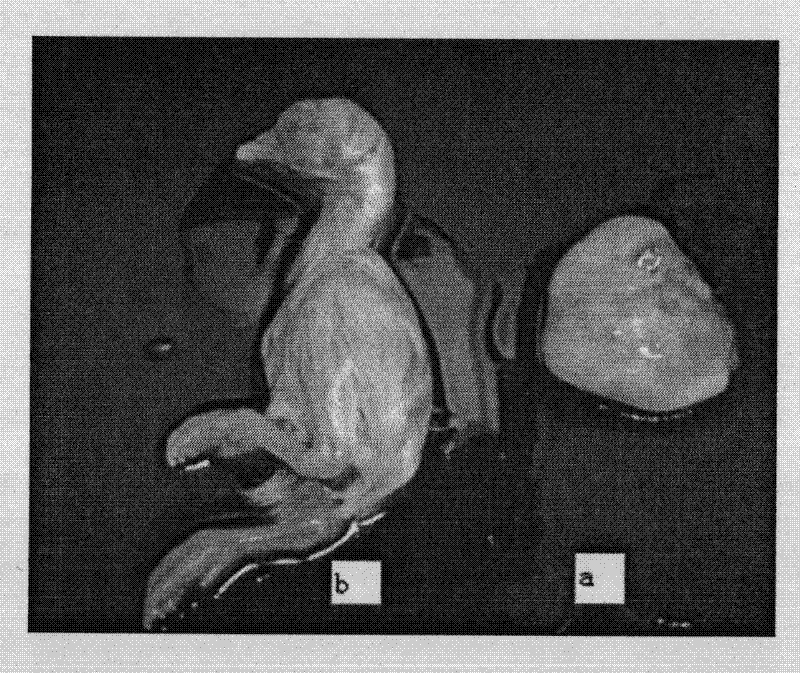Avian infectious bronchitis virus (IBV) as well as culture method and application thereof
A coronavirus and duck-derived technology, applied in the field of bioengineering, can solve the problems of chicken immune failure and lack of cross-protection
- Summary
- Abstract
- Description
- Claims
- Application Information
AI Technical Summary
Problems solved by technology
Method used
Image
Examples
Embodiment 1
[0023] Example 1 Virus Isolation and Culture
[0024] In May 2004, a suspected IB disease with diarrhea and growth retardation as the main symptoms occurred in a farm in Zhengzhou, Henan Province. The infected chickens mainly showed depression, diarrhea, slow growth and decreased resistance. The morbidity rate was 100%, and the mortality rate was 100%. Reaching more than 10%, the production performance of infected flocks is significantly reduced. According to the investigation, there was a group of 1700 meat ducks only about 150m away from the chicken coop. About 10 days before the first batch of chickens became ill, the duck group had a disease with similar symptoms, but did not cause a large number of deaths. The lesions of dead chickens are mainly small intestinal bleeding, intestinal wall thinning, some have ulceration, small intestinal villi shedding, glandular stomach papilla swelling, mucosal shedding, some have bleeding at the junction of gizzard and glandular stomach,...
Embodiment 2
[0025] Embodiment 2 virus identification
[0026] (1) Chicken embryo median lethal dose (ELD) 50 ) determination
[0027] The above-mentioned gained seed poison (duck-derived coronavirus ZZ2004) is diluted by 10 times, and 10 -3 ~10 -7 Chicken embryos were inoculated with each dilution, and five 9-11-day-old SPF chicken embryos were inoculated for each dilution, cultured at 37°C, and dead chicken embryos within 24 hours were discarded, and the number of dead embryos was observed and recorded every day until the age of 18 embryos. Calculation of ELD by Reed-Muench method 50 (Reed and Muench, 1938).
[0028] (2) RT-PCR identification of virus ZZ2004 strain
[0029] The primer sequences were designed as follows: upstream primer 5'-GACCGCTTGTCAAAGCAAATT-3', downstream primer 5'-TGAGTACTAAGAGTGCAATT-3'.
[0030] Concentration method of ZZ2004 strain
[0031] Dilute the allantoic fluid infected by the ZZ2004 strain 1:10 with sterilized PBS, inoculate 0.2ml into the chorioalla...
Embodiment 3
[0053] The physicochemical test of embodiment 3 virus
[0054] (1) Sensitivity test of virus to ether and chloroform
[0055] ① Sensitivity test of the virus to 20% ether: Take 800ul of ZZ2004 virus in a sterile ep tube, add 200ul of ether, put it in a refrigerator at 4°C for 18-24h, shake it well from time to time, centrifuge at 2500rpm at 4°C for 20min, and take The liquid in the lower layer was repeatedly blown to evaporate the ether. Determination of its EID by diluting with sterile saline 50 , and a virus control group was set up at the same time. The test results are shown in Table 4.
[0056] ② Sensitivity test of virus to 0.5% chloroform: Take 995ul of CSISV virus in a sterile EP tube, add 5ul of chloroform, put it in a refrigerator at 4°C for 20min, shake it well from time to time, centrifuge at 2500rpm at 4°C for 20min, and take the upper liquid Determination of its EID by diluting with sterile saline 50 , and a virus control group was set up at the same time. ...
PUM
 Login to View More
Login to View More Abstract
Description
Claims
Application Information
 Login to View More
Login to View More - R&D
- Intellectual Property
- Life Sciences
- Materials
- Tech Scout
- Unparalleled Data Quality
- Higher Quality Content
- 60% Fewer Hallucinations
Browse by: Latest US Patents, China's latest patents, Technical Efficacy Thesaurus, Application Domain, Technology Topic, Popular Technical Reports.
© 2025 PatSnap. All rights reserved.Legal|Privacy policy|Modern Slavery Act Transparency Statement|Sitemap|About US| Contact US: help@patsnap.com



